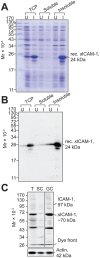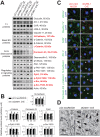Intercellular adhesion molecule-1 is a regulator of blood-testis barrier function
- PMID: 22976294
- PMCID: PMC3575703
- DOI: 10.1242/jcs.107987
Intercellular adhesion molecule-1 is a regulator of blood-testis barrier function
Abstract
The mechanism underlying the movement of preleptotene/leptotene spermatocytes across the blood-testis barrier (BTB) during spermatogenesis is not well understood largely owing to the fact that the BTB, unlike most other blood-tissue barriers, is composed of several co-existing and co-functioning junction types. In the present study, we show that intercellular adhesion molecule-1 [ICAM-1, a Sertoli and germ cell adhesion protein having five immunoglobulin (Ig)-like domains, in addition to transmembrane and cytoplasmic domains] is a regulator of BTB integrity. Initial experiments showed ICAM-1 to co-immunoprecipitate and co-localize with tight junction and basal ectoplasmic specialization proteins such as occludin and N-cadherin, which contribute to BTB function. More importantly, overexpression of ICAM-1 in Sertoli cells in vitro enhanced barrier function when monitored by transepithelial electrical resistance measurements, illustrating that ICAM-1-mediated adhesion can promote BTB integrity. On the other hand, overexpression of a truncated form of ICAM-1 that consisted only of the five Ig-like domains (sICAM-1; this form of ICAM-1 is known to be secreted) elicited an opposite effect when Sertoli cell barrier function was found to be perturbed in vitro; in this case, sICAM-1 overexpression resulted in the downregulation of several BTB constituent proteins, which was probably mediated by Pyk2/p-Pyk2-Y402 and c-Src/p-Src-Y530. These findings were expanded to the in vivo level when BTB function was found to be disrupted following sICAM-1 overexpression. These data illustrate the existence of a unique mechanism in the mammalian testis where ICAM-1 can either positively or negatively regulate BTB function.
Figures







Similar articles
-
Exploring the evolving function of soluble intercellular adhesion molecule-1 in junction dynamics during spermatogenesis.Front Endocrinol (Lausanne). 2024 Jan 8;14:1281812. doi: 10.3389/fendo.2023.1281812. eCollection 2023. Front Endocrinol (Lausanne). 2024. PMID: 38260159 Free PMC article. Review.
-
Disruption of Sertoli-germ cell adhesion function in the seminiferous epithelium of the rat testis can be limited to adherens junctions without affecting the blood-testis barrier integrity: an in vivo study using an androgen suppression model.J Cell Physiol. 2005 Oct;205(1):141-57. doi: 10.1002/jcp.20377. J Cell Physiol. 2005. PMID: 15880438
-
rpS6 Regulates blood-testis barrier dynamics by affecting F-actin organization and protein recruitment.Endocrinology. 2012 Oct;153(10):5036-48. doi: 10.1210/en.2012-1665. Epub 2012 Sep 4. Endocrinology. 2012. PMID: 22948214 Free PMC article.
-
Connexin 43 and plakophilin-2 as a protein complex that regulates blood-testis barrier dynamics.Proc Natl Acad Sci U S A. 2009 Jun 23;106(25):10213-8. doi: 10.1073/pnas.0901700106. Epub 2009 Jun 9. Proc Natl Acad Sci U S A. 2009. PMID: 19509333 Free PMC article.
-
Intercellular adhesion molecules (ICAMs) and spermatogenesis.Hum Reprod Update. 2013 Mar-Apr;19(2):167-86. doi: 10.1093/humupd/dms049. Epub 2013 Jan 3. Hum Reprod Update. 2013. PMID: 23287428 Free PMC article. Review.
Cited by
-
Testicular germ cell tumors arise in the absence of sex-specific differentiation.Development. 2021 May 1;148(9):dev197111. doi: 10.1242/dev.197111. Epub 2021 Apr 26. Development. 2021. PMID: 33912935 Free PMC article.
-
Tumor necrosis factor α-mediated restructuring of the Sertoli cell barrier in vitro involves matrix metalloprotease 9 (MMP9), membrane-bound intercellular adhesion molecule-1 (ICAM-1) and the actin cytoskeleton.Spermatogenesis. 2012 Oct 1;2(4):294-303. doi: 10.4161/spmg.22602. Spermatogenesis. 2012. PMID: 23248771 Free PMC article.
-
Sertoli cell survival and barrier function are regulated by miR-181c/d-Pafah1b1 axis during mammalian spermatogenesis.Cell Mol Life Sci. 2022 Aug 25;79(9):498. doi: 10.1007/s00018-022-04521-w. Cell Mol Life Sci. 2022. PMID: 36008729 Free PMC article.
-
Differential effects of c-Src and c-Yes on the endocytic vesicle-mediated trafficking events at the Sertoli cell blood-testis barrier: an in vitro study.Am J Physiol Endocrinol Metab. 2014 Oct 1;307(7):E553-62. doi: 10.1152/ajpendo.00176.2014. Epub 2014 Aug 12. Am J Physiol Endocrinol Metab. 2014. PMID: 25117412 Free PMC article.
-
Exploring the evolving function of soluble intercellular adhesion molecule-1 in junction dynamics during spermatogenesis.Front Endocrinol (Lausanne). 2024 Jan 8;14:1281812. doi: 10.3389/fendo.2023.1281812. eCollection 2023. Front Endocrinol (Lausanne). 2024. PMID: 38260159 Free PMC article. Review.
References
-
- Byers S. W., Hadley M. A., Djakiew D., Dym M. (1986). Growth and characterization of polarized monolayers of epididymal epithelial cells and Sertoli cells in dual environment culture chambers. J. Androl. 7, 59–68 - PubMed
-
- Cheng C. Y., Bardin C. W. (1987). Identification of two testosterone-responsive testicular proteins in Sertoli cell-enriched culture medium whose secretion is suppressed by cells of the intact seminiferous tubule. J. Biol. Chem. 262, 12768–12779 - PubMed
-
- Cheng C. Y., Mruk D. D. (2002). Cell junction dynamics in the testis: Sertoli-germ cell interactions and male contraceptive development. Physiol. Rev. 82, 825–874 - PubMed
Publication types
MeSH terms
Substances
Grants and funding
LinkOut - more resources
Full Text Sources
Other Literature Sources
Molecular Biology Databases
Research Materials
Miscellaneous

